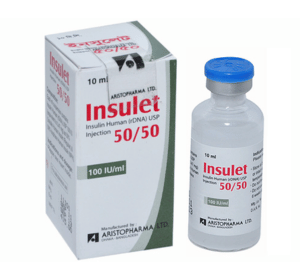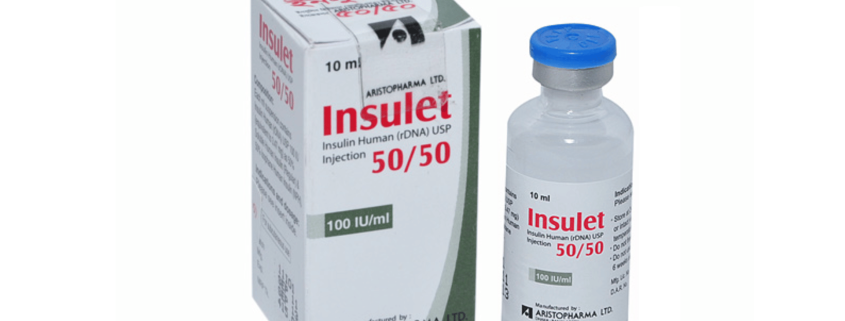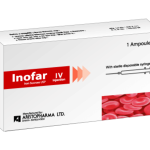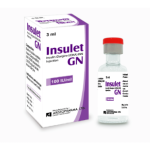Insulet (Insulin Human (rDNA))

Therapeutic Group : Antidiabetic
Presentation:
Insulet R Injection 100 IU/ml: Each ml solution contains Insulin Human rDNA) USP 100 IU (equivalent to 3.47 mg) as Soluble Insulin Human(Regular).
Insulet N Injection 100 IU/ml: Each ml suspension contains Insulin Human (rDNA) USP 100 IU (equivalent to 3.47 mg) as Isophane Insulin Human (NPH).
Insulet 30/70 Injection 100 IU/ml: Each ml suspension contains Insulin Human (rDNA) USP 100 IU (equivalent to 3.47 mg) as 30% Soluble Insulin Human (Regular) and 70% Isophane Insulin Human (NPH).
Insulet 50/50 Injection 100 IU/ml: Each ml suspension contains Insulin Human (rDNA) USP 100 IU (equivalent to 3.47 mg) as 50% Soluble Insulin Human (Regular) and 50% Isophane Insulin Human (NPH).
Indications:
Indications:
•Treatment of all patients with type 1 diabetes
•Treatment of patients with type 2 diabetes who are not adequately controlled by diet and/or oral hypoglycemic agents
•For the initial stabilization of diabetes in patients with diabetic ketoacidosis, hyperosmolar non-ketotic syndrome and during periods of stress such as severe infections and major surgery in diabetic patients
•Treatment of gestational diabetes
Dosage & Administration:
Dosage is individualized and determined by the physician in accordance with the needs of the patient.
The average range of total daily insulin requirement for maintenance therapy in type 1 diabetic patients lies between 0.5 and 1.0 IU/kg. However, in pre-pubertal children it usually varies from 0.7 to 1.0 IU/kg, but can be much lower during the period of partial remission. In insulin resistance, e.g. during puberty or due to obesity, the daily insulin requirement may be substantially higher. Initial dosages for type 2 diabetic patients are often lower, e.g. 0.3 to 0.6 IU/kg/day.
Method of administration:
An injection should be followed by a meal or snack containing carbohydrates within 30 minutes. Injection is administered subcutaneously in the upper arm, thigh, buttock or abdominal wall. A subcutaneous injection into the abdominal wall results in a faster absorption than from other injection sites. Insulet R can be given intravenously only by the physician in emergency situations. However, Insulet N, Insulet 30/70 & Insulet 50/50 are never to be administered intravenously.
1. Preparation before use:
•Clean your hands.
•Shake or rotate the vial gently to mix the solution uniformly and check if the insulin has the normal appearance.
•In case of using a new vial, flip off the plastic protective cap and wipe the rubber plug with an alcohol swab.
•Draw air into your syringe equal to the amount of insulin needed.
•Puncture the needle into the vial and inject the air.
•Turn the bottle and syringe upside down and withdraw correct dose of insulin into the syringe.
•Before pulling out the needle, check if there are any bubbles remain in the syringe. If so, put the syringe upright and tap the syringe to discharge the air bubbles.
2. Injection site:
•Choose the area where skin is less tight, such as the upper arm, thigh, buttock or abdomen.
•To avoid tissue damage, choose a site for each injection that is at least 1 cm from the previous injection site.
3. Injection method:
•Cleanse the skin with alcohol where the injection is to be made.
•Put the needle in such a position as to form 45° angle with the skin.
•Puncture the needle into skin and inject insulin.
•Keep the needle under the skin for at least 6 seconds to make sure the entire dose is injected.
•Pull the needle out and apply gentle pressure over the injected site for several seconds.
•Do not rub the injection site.
Contrainidications:
Contraindicated in hypoglycemia and hypersensitivity to Human Insulin or any of the excipients.
Warning & Precautions:
Inadequate dosing or discontinuation of treatment, especially in type 1 diabetes, may lead to hyperglycemia. In type 1 diabetes, untreated hyperglycemic events eventually lead to diabetic ketoacidosis which is potentially lethal. Hypoglycemia may occur if the insulin dose is too high in relation to the insulin requirement. If an adjustment is needed, it may occur with the first dose or during the first several weeks or months. Patients whose blood glucose control is greatly improved e.g. by intensified insulin therapy, may experience a change in their usual warning symptoms of hypoglycemia and should be advised accordingly.
Side effects:
Hypoglycemia may occur suddenly. Severe hypoglycemia may lead to unconsciousness and/or convulsions and may result in temporary or permanent impairment of brain function or even death. Symptoms of generalized hypersensitivity may include generalized skin rash, itching, sweating, gastrointestinal upset, angioneurotic edema, difficulties in breathing, palpitation and reduction in blood pressure. Fast improvement in blood glucose control may be associated with acute painful neuropathy, which is usually reversible. Lipodystrophy may occur at the injection site as a consequence of failure to rotate injection sites within an area. Injection site reactions (redness, swelling, itching, pain and hematoma at the injection site) may occur, most of which are transitory and disappear during continued treatment. Edema may occur upon initiation of therapy and it is also transitory.
Drug interaction:
A number of medicinal products are known to interact with the glucose metabolism. The physician must therefore take possible interactions into account and should always ask their patients about any medicinal products they take. The substances which may reduce insulin requirement are: Oral hypoglycemic agents (OHA), monoamine oxidase inhibitors (MAOI), non-selective beta-blockers, angiotensin converting enzyme (ACE) inhibitors, salicylates and alcohol. The substances which may increase insulin requirement are: Thiazides, glucocorticoids, thyroid hormones and beta-sympathomimetics, growth hormone and danazol. Beta-blockers may mask the symptoms of hypoglycemia and delay recovery from hypoglycemia. Octreotide/lanreotide may both decrease and increase insulin requirement. Alcohol may intensify and prolong the hypoglycemic effect of insulin.
Use in special groups:
Use in pregnancy & lactation: There are no restrictions on the treatment of diabetes with insulin during pregnancy as insulin does not pass the placental barrier. There are no restrictions on the treatment of diabetes with insulin during lactation, as insulin treatment of the nursing mother involves no risk to the baby. However, the insulin dosage, diet or both may need to be adjusted.
Packing:
Insulet R Injection 100 IU/ml: Each glass vial contains 4 ml / 10 ml solution.
Insulet N Injection 100 IU/ml: Each glass vial contains 4 ml / 10 ml suspension.
Insulet 30/70 Injection 100 IU/ml: Each glass vial contains 4 ml / 10 ml suspension.
Insulet 50/50 Injection 100 IU/ml: Each glass vial contains 4 ml / 10 ml suspension.



